Stacking GABA and Glycine for Deeper Rest
😴 Introduction: The Quest for Deep, Restorative Sleep
You crawl into bed, exhausted from the day — but your brain refuses to slow down. Thoughts race, tension lingers, and true rest feels out of reach.
Sound familiar?
For millions, the problem isn’t just falling asleep — it’s staying asleep and entering the deep, restorative phases where healing, growth, and memory consolidation happen.
That’s where GABA and glycine, two naturally occurring amino acids, come into play.
They’re not sedatives. They’re not sleeping pills. Instead, they gently calm the nervous system, balance brain activity, and create the perfect biochemical environment for deep, uninterrupted rest. 🌿
In this article, you’ll learn:
What GABA and glycine are and how they work
Why stacking them together can enhance sleep quality
The science behind their synergistic effects
How to use them safely for long-term sleep support
Let’s dive into the calming science of sleep. 🌌
Looking for supplements for This? Click here.
🧠 Part 1: Understanding GABA — The Brain’s Brake Pedal

⚙️ What Is GABA?
GABA (Gamma-Aminobutyric Acid) is the brain’s primary inhibitory neurotransmitter — meaning it helps slow down neural activity.
Think of GABA as the brake system for your mind and body.
While excitatory neurotransmitters like glutamate keep you alert, GABA restores calm and balance.
When GABA binds to its receptors, it opens chloride channels that hyperpolarize neurons, making them less likely to fire. This reduces anxiety, quiets racing thoughts, and relaxes muscles.
🌿 Signs You May Have Low GABA
Trouble falling asleep or staying asleep
Feeling anxious or “wired but tired”
Muscle tightness or jaw clenching
Restless thoughts at bedtime
Overreaction to stress
Modern life — chronic stress, caffeine overuse, sleep deprivation — depletes GABA signaling.
That’s why restoring this balance can make such a dramatic difference in how deeply you rest.
💤 What GABA Does During Sleep
GABA activity rises in the brain at night, especially during the transition from wakefulness to sleep.
It initiates sleep onset by inhibiting wake-promoting neurons.
It helps maintain slow-wave sleep (deep sleep) — the most restorative stage for tissue repair and immune regulation.
It reduces REM interruptions caused by stress hormones.
In essence, GABA turns off the “mental noise” so your body can fully relax.
🧬 Part 2: Understanding Glycine — The Body’s Cooling Agent
🌡️ What Is Glycine?
Glycine is a simple amino acid that acts as both a neurotransmitter and a metabolic regulator.
While GABA calms the brain, glycine helps the body wind down.
It’s found abundantly in collagen, gelatin, and connective tissue — meaning most people don’t get enough unless they consume bone broth or collagen supplements.
❄️ How Glycine Promotes Sleep
Glycine lowers your core body temperature, which is essential for falling asleep.
When you go to bed, your body naturally cools by about 1°C (1.8°F). This drop signals your brain that it’s time for rest.
Glycine amplifies this effect by improving blood flow to the skin, helping dissipate heat more efficiently.
It also:
Increases serotonin (the precursor to melatonin)
Reduces daytime fatigue even with reduced sleep
Enhances deep sleep wave amplitude — meaning more restorative slow-wave sleep
🌿 Signs of Low Glycine
Muscle tightness or soreness
Poor sleep quality or unrefreshing sleep
Brain fog or fatigue
Craving sugar or stimulants for energy
Stiff joints or poor collagen production
Since glycine is a non-essential amino acid, your body can make it — but stress, aging, and low-protein diets can create higher demands than you can meet naturally.
Looking for supplements for This? Click here.
🧩 Part 3: Why GABA and Glycine Work Better Together
Separately, both GABA and glycine promote relaxation. Together, they synergize through complementary mechanisms in the nervous system.
Let’s break down how stacking them creates a full-spectrum calm.
⚖️ 1️⃣ Dual Neurotransmitter Pathways
GABA binds to GABA-A and GABA-B receptors in the brain.
Glycine binds to glycine receptors in the spinal cord and brainstem.
These systems interact. Glycine receptors are co-located with GABA receptors in key areas regulating muscle tone and sleep architecture.
When both are activated, they produce a deeper state of inhibition — slowing down nerve firing and relaxing both the mind and body.
💫 2️⃣ Complementary Calm: Brain + Body
GABA quiets mental chatter and stress reactivity.
Glycine relaxes muscles and temperature regulation.
The result is a full-spectrum relaxation effect:
🧠 Calm mind + 🦵 Relaxed body = 💤 Deeper rest.
🧘 3️⃣ Enhanced Slow-Wave Sleep
Studies show that GABA and glycine both increase slow-wave activity (deep sleep phase).
When combined, they create an additive effect:
You fall asleep faster
Stay asleep longer
Spend more time in deep, restorative sleep stages
This is where growth hormone is released, tissues repair, and memory consolidates — all critical for long-term health.
🧬 4️⃣ Regulating Cortisol and Adrenal Balance
Chronic stress elevates cortisol — the enemy of sleep.
GABA directly reduces adrenal output, while glycine buffers the fight-or-flight response by modulating excitatory neurotransmitters like norepinephrine.
Together, they teach your nervous system to switch off stress more efficiently at night.
🔋 5️⃣ Neuroprotection and Recovery
Both amino acids protect brain cells from oxidative stress and excitotoxicity (damage from overactive neurons).
They improve mitochondrial function and reduce inflammation, which is crucial for long-term cognitive health.
That’s why GABA and glycine stacks are increasingly used by athletes, high performers, and people recovering from burnout.
🧘 Part 4: The Science of Sleep Synergy
Let’s look at what research says about their individual and combined effects.
🧠 GABA Research Highlights
GABA supplementation (100–200 mg) increases alpha brain waves and reduces beta activity — a pattern seen in relaxed wakefulness and early sleep.
In clinical studies, PharmaGABA® (a natural fermented form) has shown improvements in sleep onset and sleep maintenance.
GABA also helps lower heart rate and blood pressure, further supporting parasympathetic dominance.
❄️ Glycine Research Highlights
Amino acid trials (3 g nightly) found significant improvements in sleep quality, fatigue, and daytime alertness.
EEG studies show that glycine increases slow-wave activity and shortens time to sleep onset.
Even with partial sleep deprivation, glycine helps maintain cognitive performance and mood stability.
🔬 Combined Effects in Practice
Although few human trials have studied the exact GABA + glycine combo, the overlapping neurochemical pathways make their synergy biologically sound.
Anecdotal and clinical experience suggests this stack:
Helps people fall asleep faster
Improves perceived sleep depth
Reduces nighttime awakenings
Enhances morning mood and focus
🌿 Part 5: How to Stack GABA and Glycine
Here’s how to safely and effectively build your GABA + Glycine nighttime stack.
🧴 Dosage Guidelines
| Supplement | Typical Dose | Timing | Notes |
|---|---|---|---|
| GABA (PharmaGABA®) | 100–200 mg | 30–60 min before bed | Start low; too high can cause tingling |
| Glycine | 3 g | 30–60 min before bed | Mix in warm water or collagen drink |
💡 Synergy tip: Combine both in a calming drink — like warm chamomile or lemon balm tea.
🌙 Add-On Synergists
For an even smoother experience, pair with:
Magnesium glycinate (200–300 mg) — enhances GABA activity.
L-Theanine (200 mg) — increases alpha waves and promotes calm alertness.
Tart cherry extract (480 mg) — boosts melatonin naturally.
⚡ Stack Example: “Deep Calm Night Formula”
1 hour before bed:
GABA 150 mg
Glycine 3 g
Magnesium glycinate 250 mg
Chamomile tea
Optional: add 0.3 mg melatonin for travel or major schedule changes.
Result: calm mind, relaxed muscles, steady sleep. 🌙
🕒 Timing and Consistency
Take the combo at the same time nightly, ideally 60 minutes before sleep.
Avoid stimulants (coffee, pre-workout, nicotine) after 2 p.m., as they counteract GABAergic effects.
Consistency matters — the benefits build over 1–2 weeks as your nervous system learns a new rhythm.
⚠️ Part 6: Safety and Side Effects
🧪 Tolerance and Dependence
Unlike sedative medications (benzodiazepines or Z-drugs), GABA and glycine are non-habit forming and do not suppress natural neurotransmitter production.
⚠️ Possible Mild Effects
Tingling or warmth (from high GABA doses)
Mild stomach upset (from excess glycine powder)
Start low and adjust gradually.
🚫 Avoid Combining With
Alcohol (also increases GABA activity)
High doses of prescription sleep aids or anti-anxiety meds (may over-sedate)
If taking antidepressants or mood stabilizers, consult your healthcare provider before adding GABA-based supplements.
🧩 Part 7: Building the Right Environment
Even the best supplement stack won’t override poor habits. Combine your GABA + glycine ritual with sleep hygiene foundations:
🌡️ Keep the Room Cool (18–20°C / 65–68°F)
Glycine’s temperature-lowering effect works best in a cool environment.
💡 Dim the Lights Early
Blue light suppresses melatonin. Use warm or red lighting after sunset.
🧘 Wind Down Mindfully
Pair your supplements with calming routines:
4-7-8 breathing
Gentle yoga or stretching
Gratitude journaling
🛏️ Make Your Bed a Sanctuary
Reserve it for sleep or intimacy only.
No phones, laptops, or late-night scrolling.
☀️ Morning Light
Get sunlight within 30 minutes of waking. This resets your circadian rhythm, helping GABA and glycine’s effects stay consistent day-to-day.
🌈 Part 8: Who Can Benefit Most from This Stack
People with stress-related insomnia
Those who wake up frequently at night
Individuals with overactive minds or anxiety before bed
Athletes needing deeper muscle recovery
Anyone transitioning from stimulant-heavy lifestyles (coffee, pre-workouts, etc.)
🌙 Part 9: How Long Until You Notice Results?
| Time Frame | What to Expect |
|---|---|
| First night | Easier relaxation and faster sleep onset |
| 3–5 days | Fewer awakenings, more vivid dreams |
| 2–3 weeks | Consistent deep sleep, improved mood and focus |
| 1 month+ | Nervous system recalibrates — calmer baseline |
🧬 Part 10: The Future of Amino Acid Sleep Stacks
Researchers are exploring how amino acid neurotransmitters like GABA, glycine, and taurine may prevent neurodegeneration and improve emotional regulation.
They not only promote rest — they may also protect the brain from overstimulation, improve focus, and enhance resilience.
The “GABA-glycine axis” represents a new frontier in biohacking calm: supporting natural brain chemistry rather than forcing sedation.
🌠 Final Thoughts: Rest as a Skill

True rest isn’t just the absence of wakefulness — it’s a physiological state of safety and surrender.
By stacking GABA and glycine, you’re not drugging yourself to sleep.
You’re teaching your nervous system to remember calm — naturally, gently, and sustainably.
Sleep isn’t something you chase; it’s something you allow.
And with the right support, your body already knows how to get there. 🌙💤
Looking for online therapy ? Click Here.
📚 References
Kimura, K. et al. “L-Theanine Reduces Psychological and Physiological Stress Responses.” Biological Psychology, 2007.
Bannai, M. et al. “Administration of Glycine Improves Subjective Sleep Quality.” Sleep and Biological Rhythms, 2012.
Abascal, J. “The Role of GABA in Human Sleep Regulation.” Frontiers in Neuroscience, 2019.
Yamadera, W. et al. “Glycine Ingestion Improves Sleep Quality.” Journal of Pharmacological Sciences, 2007.
Takahashi, M. et al. “Effects of GABA on Sleep and Relaxation.” Journal of Nutritional Science and Vitaminology, 2019.
Peuhkuri, K. et al. “Diet and Sleep: Nutrients in Sleep Regulation.” Nutrients, 2012.
Huberman, A. “Tools for Better Sleep and Stress Recovery.” Huberman Lab Podcast, 2023.
Sarris, J. et al. “Nutritional and Herbal Sleep Aids: Mechanisms and Evidence.” Phytotherapy Research, 2020.
Wienecke, E. et al. “Magnesium and GABAergic Function in Sleep Quality.” J. Res. Med. Sci., 2016.
Walker, M. Why We Sleep. Scribner, 2017.
Related Posts
-
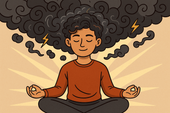
How to Regain Focus After Emotional Stress
After emotional stress, your nervous system feels frayed — your focus fades, thoughts race, and calm seems impossible. Learn how to restore balance, rebuild concentration, and retrain your brain for clarity and peace through evidence-based mind–body tools. 🌿
-
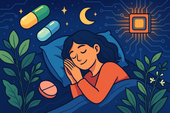
The Future of Sleep Supplements
The future of sleep supplements is here — where science meets nature. Discover how next-generation formulas use adaptogens, amino acids, and biotech innovations to support deep, restorative sleep without dependency. 🌙
-
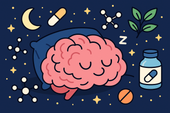
Emerging Research on Sleep and Nootropics
Can nootropics help you sleep better? Discover how compounds like L-theanine, magnesium threonate, ashwagandha, and Alpha-GPC influence neurotransmitters, circadian rhythm, and brain recovery — bridging the gap between smarter days and deeper nights. 🌙
-

New Herbal Extracts for Deep Sleep
Discover the next generation of herbal extracts for deep sleep — from saffron and magnolia to jujube and lemon balm. Learn how these plant-based compounds calm the nervous system, balance cortisol, and promote truly restorative rest. 🌙
-
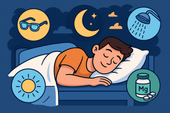
Sleep Biohacking: What Works and What Doesn’t
Biohacking your sleep can sound futuristic — from red light therapy to wearables and supplement stacks. But which hacks actually help, and which are just hype? Discover the science-backed sleep strategies that truly improve rest, recovery, and brain health. 🌙
-
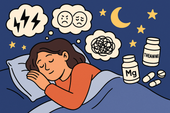
Sleep Support for People with Anxiety Disorders
💭 A restless mind can keep you up all night — thoughts spinning, heart racing, and peace feeling far away. Learn how to quiet overthinking, regulate your nervous system, and create a nightly ritual that teaches your brain to let go and rest deeply. 🌙
-
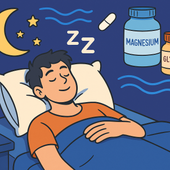
How to Fall Back Asleep After Waking Up
Waking up in the middle of the night? Learn how to fall back asleep quickly and calmly using breathing techniques, stress-reducing rituals, and natural supplements like magnesium and glycine. Restore your body’s rhythm and wake up feeling refreshed.
-
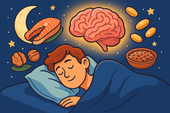
The Role of Omega-3s in Sleep Quality
-

Overcoming Jet Lag with Supplements
✈️ Jet lag doesn’t have to ruin your trip! Discover how supplements like melatonin, magnesium, L-theanine, and tart cherry can help you reset your body clock faster, reduce fatigue, and recover energy naturally after long flights. 🌙
-
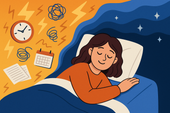
Managing Sleep During Times of Stress
Feeling wired and restless? Learn how to manage sleep during stressful times through nutrition, breathwork, and natural supplements like magnesium and L-theanine. Discover how to calm your nervous system and restore deep, peaceful rest—even when life feels overwhelming.
-
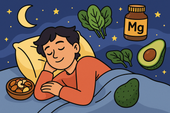
The Role of Magnesium for Night Cramps
Night cramps keeping you awake? Discover how magnesium helps relax muscles, balance electrolytes, and prevent painful spasms. Learn which forms work best, how to take them, and how to pair them with other nutrients for cramp-free, peaceful sleep.
-
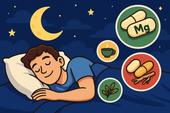
Supplements That Reduce Nighttime Awakenings
🌙 Discover science-backed supplements that help you stay asleep through the night. From magnesium and L-theanine to glycine and ashwagandha, learn how these natural compounds calm your nervous system, balance cortisol, and prevent 2 a.m. wake-ups for deeper, more restorative rest.
-
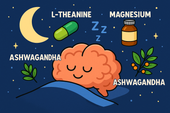
Nootropics That Promote Calm and Rest
Explore the world of calming nootropics — natural brain enhancers that promote relaxation, better focus, and deeper rest. Learn how L-Theanine, magnesium, ashwagandha, and other adaptogens help balance your nervous system, reduce stress, and support restorative sleep.
-
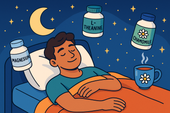
Best Natural Supplement Stack for Sleep
Discover the best natural supplement stack for deep, restorative sleep. Learn how nutrients like magnesium, L-theanine, glycine, and calming herbs such as chamomile and ashwagandha work together to relax your body, calm your mind, and improve sleep quality—naturally and safely.
-
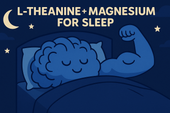
Combining L-Theanine and Magnesium for Sleep: A Calm Night, Naturally
Discover how combining L-Theanine and Magnesium can help you drift into deep, restorative sleep. Learn how this natural duo calms the mind, relaxes the body, and supports your nervous system—without grogginess the next morning.
-
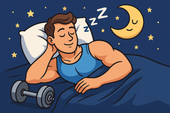
How to Sleep Better After Intense Workouts
Struggling to fall asleep after a tough workout? Learn how to optimize your post-training recovery with nutrition, hydration, and science-backed sleep strategies. Discover how to calm your nervous system, balance hormones, and wake up fully recharged for your next session.
-
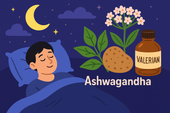
Ashwagandha and Valerian: A Bedtime Combo for Deep Rest and Emotional Reset
Discover the calming synergy of Ashwagandha and Valerian root, two natural sleep aids that help quiet the mind, ease anxiety, and promote deeper rest. Learn how this herbal duo supports the nervous system, balances stress hormones, and restores emotional peace — without next-day grogginess.
-
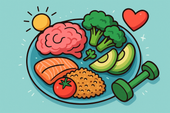
How to Create a Resilience-Boosting Diet
Discover how to build emotional and physical strength from the inside out with a resilience-boosting diet 🍎. Learn which foods stabilize your mood, how supplements like magnesium and omega-3s strengthen your stress response, and why pairing nutrition with breathwork and therapy creates lasting calm, focus, and vitality 🌿💪.
-

Best Teas and Herbal Blends for Calmness: Nature’s Way to Restore Inner Peace
Ashwagandha, the ancient adaptogenic herb, helps your body find balance during stress. Known as “Indian ginseng,” it supports cortisol regulation, boosts energy, and restores calm clarity. Discover how this powerful root promotes resilience, emotional balance, and steady vitality — one cup at a time. 🌸
-

Parenting and Emotional Strength: How to Raise Children Without Losing Yourself
Empathy is the bridge that connects hearts — the quiet power to understand, feel, and support another’s emotions without judgment. Learn how empathy strengthens relationships, enhances communication, and cultivates deeper compassion in everyday life. 🌿
-

How to Bounce Back from Public Failure: Reclaiming Confidence, Purpose, and Power
Visualization is more than imagination — it’s brain training for resilience. By picturing calm, success, or healing, you activate the same neural pathways as real experience. Learn how daily visualization rewires your brain for confidence, emotional balance, and recovery from stress. ✨
-

Coping with Financial Stress Through Resilience: How to Stay Grounded When Money Feels Tight
Body awareness is the foundation of emotional resilience. By tuning into your body’s signals — tension, fatigue, or calm — you learn to recognize stress before it overwhelms you. Discover how mindfulness, gentle movement, and breathwork can deepen your connection with your body and restore balance from the inside out. 🧘
-

How to Stay Positive During Chronic Illness: A Guide to Emotional Strength and Hope
Creativity is more than art — it’s a form of healing. Whether through painting, writing, music, or small acts of expression, creativity helps release emotion, calm the nervous system, and reconnect you to joy. Discover how to use creativity as a tool for emotional balance, resilience, and self-discovery. 🌿
-

Resilience Tips for Caregivers: How to Stay Strong While Caring for Others
Joy isn’t the absence of pain — it’s the quiet strength to find light even in challenging times. Cultivating joy through small daily moments restores balance, releases stress, and reminds you of life’s beauty. Learn how to reconnect with authentic happiness, rebuild emotional energy, and nurture your nervous system through gratitude, presence, and play. 🌿
-

Building Resilience After a Breakup: How to Heal, Rebuild, and Rise Stronger
Social connection is one of the strongest predictors of emotional resilience. During difficult times, genuine relationships act as anchors — calming the nervous system, reducing stress hormones, and helping you regain perspective. Learn how cultivating real human connection can strengthen your mind, heart, and overall well-being. 🌿
-
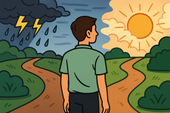
How to Stay Emotionally Strong During Job Loss
Your emotions are powered by brain chemistry — a delicate balance of neurotransmitters like serotonin, dopamine, and cortisol. When these chemicals work in harmony, you feel calm, focused, and resilient. Learn how daily habits, nutrition, and mindfulness can support your brain chemistry and boost emotional well-being naturally. 🌿
-
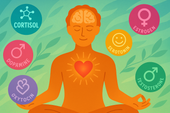
The Role of Hormones in Emotional Stability: How Your Chemistry Shapes Your Calm
Hormones shape more than your body — they shape your emotions, resilience, and sense of calm. From cortisol to serotonin, these chemical messengers influence how you react to stress, connect with others, and recover from challenges. Learn how to balance your hormones naturally to build lasting emotional stability and harmony within. 💫
-

Mitochondria and Emotional Energy: The Cellular Power Behind Your Mood
Breathwork is one of the most powerful tools for emotional regulation and cellular balance. Through intentional breathing, you can calm your nervous system, increase oxygen flow to the brain, and even support mitochondrial energy. Learn how conscious breathing connects body and mind — transforming stress into presence and emotional strength. 🌿
-

Inflammation and Its Impact on Mood Resilience: The Silent Link Between Body and Mind
Inflammation doesn’t just affect the body — it impacts the mind. Chronic inflammation alters brain chemistry, depletes serotonin, and makes emotional recovery harder. Learn how calming inflammation through nutrition, mindfulness, and sleep can restore balance, resilience, and a renewed sense of emotional strength. 💫
-
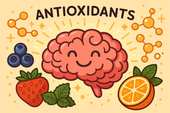
How Antioxidants Protect Emotional Well-being: The Hidden Link Between Oxidative Stress and Mental Health
Antioxidants do more than protect your body — they defend your mind. By neutralizing oxidative stress, antioxidants support serotonin, dopamine, and brain energy pathways that keep you calm, focused, and emotionally balanced. Discover how foods like berries, green tea, and dark chocolate nourish your brain, boost mood, and strengthen resilience from the inside out. 🌿✨
-
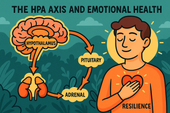
The HPA Axis and Emotional Health: The Hidden Bridge Between Stress and Mind
Neuroplasticity — the brain’s ability to rewire and adapt — is the foundation of emotional healing and resilience. When you face stress, trauma, or change, your neural pathways can reshape themselves to support new patterns of calm, focus, and self-awareness. Learn how daily practices like mindfulness, therapy, and breathwork strengthen neuroplasticity to transform emotional pain into personal growth. 🌸
-
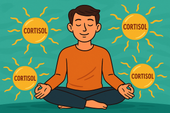
Why Cortisol Control Is Key to Resilience: Mastering Stress to Build Emotional Strength
Controlling cortisol — the body’s main stress hormone — is the secret to lasting resilience. When cortisol levels stay balanced, your mind becomes clearer, emotions steadier, and energy more sustainable. Learn how breathwork, mindset shifts, adaptogens, and daily rhythms can help you calm your stress response and build true inner strength. 🌞💪
-
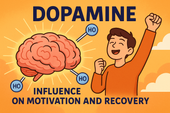
Dopamine’s Influence on Motivation and Recovery: Reigniting Drive and Balance
Healthy relationships are the foundation of emotional balance and resilience. Whether romantic, familial, or platonic, genuine connection releases dopamine, serotonin, and oxytocin — the brain’s “bonding trio” — helping us feel secure, motivated, and seen. Learn how trust, empathy, and communication not only strengthen your connections but also reshape your nervous system for deeper emotional well-being. 🌿🤝
-
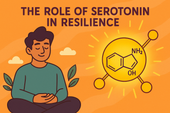
The Role of Serotonin in Resilience: How This “Mood Molecule” Shapes Emotional Strength
Serotonin — often called the “resilience molecule” — plays a vital role in how we handle stress, regulate mood, and recover from emotional challenges. Beyond happiness, this powerful neurotransmitter helps balance the gut-brain axis, stabilize the nervous system, and support emotional flexibility. Learn how nutrition, sunlight, mindfulness, and adaptogens can naturally boost serotonin and strengthen your emotional resilience. 🌞🧠
-
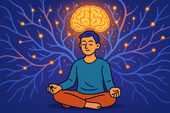
How Neuroplasticity Supports Emotional Growth: Rewiring the Brain for Resilience
Neuroplasticity is the brain’s built-in power to grow, adapt, and heal — and it’s the foundation of emotional transformation. Every mindful breath, compassionate act, or reframed thought strengthens new neural pathways that support resilience and self-awareness. Learn how your brain rewires through daily habits, helping you turn emotional challenges into opportunities for growth and calm. 🌿
-

Tai Chi and Adaptogens for Mind-Body Balance: The Art of Harmonizing Energy and Resilience
Alchemy isn’t just an ancient science — it’s a timeless symbol of transformation and inner balance. By blending the physical and spiritual, alchemy teaches us that change begins from within. Just as metals are refined into gold, we too can transmute emotional pain, stress, and chaos into clarity and strength through mindful practice and self-awareness. 🌙✨
-

Cold Therapy and Emotional Control: Training the Mind Through the Body
Cold therapy isn’t just for athletes — it’s a tool for emotional mastery. By exposing your body to controlled cold, you train your nervous system to stay calm under stress, improving focus, mood, and resilience. This article explores the science of cold exposure, its impact on hormones and the vagus nerve, and how ice baths and cold showers can help you build emotional control, one breath at a time. 🧊🧘♂️
-

How Music Influences Emotional Recovery: The Healing Soundtrack of the Mind
Neuroplasticity — the brain’s ability to rewire and heal itself — is at the heart of emotional recovery. Through mindful habits, music, therapy, and consistent mental stimulation, your brain can form new connections that support resilience and well-being. Discover how neuroplasticity turns pain into growth, helping you rebuild balance, focus, and emotional strength. 🌿
-

Nature Therapy for Building Resilience: Reconnecting With the Healing Power of the Earth
Nature therapy helps rebuild emotional resilience by reconnecting you with the healing rhythms of the Earth. From forest walks to sunlight exposure, nature restores balance to your nervous system, lowers stress hormones, and teaches emotional adaptability. Learn how spending time outdoors can enhance mental clarity, calm anxiety, and awaken your natural capacity to heal. 🌞
-
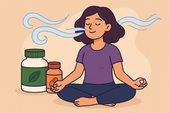
Breathwork Techniques That Pair with Supplements: The Ultimate Synergy for Stress Relief and Mental Clarity
Breathwork and supplements create a powerful mind-body synergy for stress relief, focus, and energy. By combining intentional breathing with adaptogens, nootropics, and calming nutrients, you can naturally regulate cortisol, sharpen mental clarity, and boost emotional balance. This guide explores the best breathwork techniques and supplement pairings to help you feel centered, calm, and energized from the inside out. 🌿
-
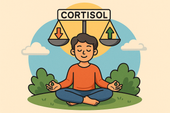
Why Cortisol Balance Matters for Emotional Strength
Balancing cortisol — your body’s main stress hormone — is essential for emotional resilience. When cortisol is chronically high, your mind stays stuck in survival mode, leading to fatigue, anxiety, and emotional instability. This article explores how nutrition, supplements, breathwork, and therapy can help restore healthy cortisol rhythms, regulate the nervous system, and strengthen your ability to handle life’s challenges with calm focus and emotional strength. 🌿
-

Best Supplements for Students During Exam Season: Focus, Energy, and Memory Support
Studying late into the night? Learn which natural supplements can boost focus, memory, and mental stamina during exam season — without the crash. From omega-3s to Bacopa and Rhodiola, discover your brain’s ultimate exam support stack. 🎓🧠
-
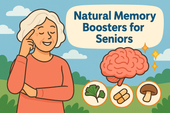
Natural Memory Boosters for Seniors: How to Keep Your Mind Sharp and Focused
Stay mentally sharp and confident as you age. Discover science-backed natural supplements and lifestyle habits that boost memory, focus, and brain longevity for seniors. 🌿🧠
-
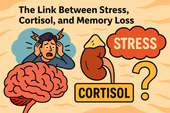
The Link Between Stress, Cortisol, and Memory Loss
Chronic stress can quietly erode your memory — and cortisol is the key culprit. Learn how stress hormones affect the brain, why the hippocampus shrinks under pressure, and how natural strategies can help you restore memory and mental clarity. 🧠✨
-
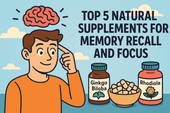
How to Build a Daily Supplement Routine for Memory Health
Want to sharpen your memory and stay mentally clear? Learn how to build a daily supplement routine for memory health — from morning focus to nighttime brain repair. Discover science-backed nutrients that boost recall, focus, and long-term cognitive resilience. 🧠🌿
-
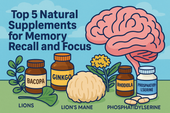
Top 5 Natural Supplements for Memory Recall and Focus
Looking to boost memory and concentration naturally? Discover the top 5 supplements — Bacopa, Ginkgo Biloba, Lion’s Mane, Rhodiola, and Phosphatidylserine — that enhance focus, recall, and long-term brain health. 🧠✨
-
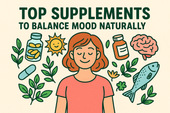
Top Supplements to Balance Mood Naturally
From omega-3s to adaptogens, discover the top natural supplements proven to support emotional balance, reduce stress, and promote inner calm — safely and effectively. 🌿✨
-
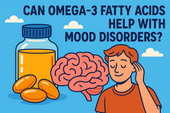
Can Omega-3 Fatty Acids Help with Mood Disorders?
Omega-3 fatty acids do more than support heart health — they can help balance mood, reduce depression, and calm anxiety. Discover how EPA and DHA nourish your brain, fight inflammation, and support emotional well-being from within. 🌊🧠
-

Vitamin D and Mood: The Sunshine Vitamin for Emotional Balance
Could the key to emotional balance be as simple as a little sunlight? Discover how vitamin D — the sunshine vitamin — influences serotonin, reduces inflammation, and helps you feel more positive and resilient year-round. ☀️💛

















































